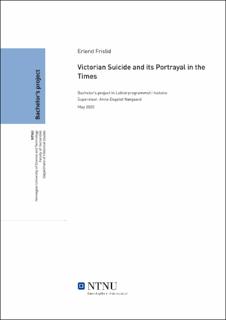| dc.description.abstract | Denne oppgaven handler om hvordan selvmord ble rapport på av den Britiske avisen Times i årene 1840-1860. Jeg har valgt ut 22 nyhetsartikler fra perioden. Disse nyhetsartiklene handler alltid om vellykkede selvmord, uten at den avdøde har begått noen andre forbrytelser utover selvmordet i seg selv.
Teksten er delt inn i seks hovedseksjoner: innledning; teori og metode; historiografi; historisk bakgrunn og kontekst; analyse; og konklusjon. Mens innledningen og konklusjonen er relativt selvforklarende med tanke på innhold, er de andre videre strukturert og jeg vil derfor gi en kort forklaring. I «teori og metode»-delen så presenteres diskursanalyse og dette relateres til oppgaven. I tillegg forekommer det en begrepsavklaring og en rask gjennomgang av tilnærmingen til kildemateriale og omstendigheter rundt Times. I «historiografi»-delen fremstilles de viktigste utviklingene mtp. selvmord som historisk objekt. Her blir det tydeliggjort at det er først etter 1980 at interessen for selvmord har vokst, og at mye fokus har blitt lagt spesielt på moderne historie, og i vestlige land. Deretter forekommer en lengre «historisk bakgrunn og kontekst»-seksjon. Den historiske bakgrunnen som gis vil basere seg på hvordan selvmord muligens har gått gjennom en sekularisering- og medikaliseringsprosess; og hvordan selvmord som et fascinasjonsobjekt har blitt håndtert av aviser og andre literære former og verk. Analysen fremstilles i form av fem temaer jeg identifserte i nyhetsartiklene. Disse er: selvmord som et medisinsk fenomen; status sin påvirkning på hvordan den avdøde fremstilles; sensasjonalisme i form av spekulasjon rundt motiv eller fokus på makabre detaljer; og til slutt moralske dømmelser – som viser seg å være et tema som er ikke-eksisterende i de nyhetsartiklene lest her.
Oppgaven vil hovedsakelig basere seg på diskursanalyse for tilnærmingen til artiklene. Her blir utdrag fra en bok og en fagartikkel basisen for forståelsen av diskursanalyse som resten av teksten kommer til å benytte seg av. Videre så presenteres en rekke teorier og modeller som vil fungere som et utgangspunkt for perspektiver og temaer som kan identifiseres i nyhetsartiklene. Her vil MacDonald’s teori om en sekulariseringsprosess i synet på selvmord fra 1660-1800 ha en sentral plass, men til enda større grad «videreføringen» av denne, der en rekke historikere har påpekt en medikalisering av selvmord som skjedde fra 1800-tallet og utover. Oppgaven baserer også til stor grad på et kapittel fra Barbara Gates sitt verk Victorian Suicide fra 1988, der hun beskriver hvordan selvmord ble sensasjonalisert i forskjellige literære former – slik som nyhetsaviser og romaner. | |
| dc.description.abstract | This paper is about how suicide was reported on by the British newspaper Times in the years 1840-1860. I have chosen 22 newspaper articles from this period. These articles are always on successful suicides, without the deceased having committed any other crime than the suicide itself.
The paper is divided into six main sections: introduction; theory and method; historiography; historical background and context; analysis; and a conclusion. While the introduction and conclusion are relatively self-explanatory in terms of content and structure, the other sections contain further sub-divisions and as such I will explain their role in the text. In the “theory and method”-section I present a short description of discourse analysis and how this is related to the paper. Furthermore, I will define some central terms and briefly outline how the source material was chosen and other circumstances surrounding the Times. In the “Historiography”-section some of the main developments in regard to suicide as a historical object will be presented. Of particular focus is research originating after 1980, as this is when most of the groundbreaking works on suicide have been published. I will also concern myself mostly with suicide as it relates to the modern period and in western Europe – not only because it is relevant to the paper itself, but because this is where most of the historical research has been done. After this follows a “historical background and context”-section. Here I will primarily present two views on suicide: one in which it is seen as having gone through secularization- and medicalization process. The other in which suicide, as an object of literary interest, has been written about, commented on in various literary forms. Finally, in the analysis section I present five themes I identified while reading the newspaper articles. These are: suicide as a medical phenomenon; the way status influences how the deceased was presented; sensationalism in terms of either speculation on motive, or how it focus on gory details; and finally, moral judgements – a theme which is entirely not present in the newspaper articles examined in this paper.
As mentioned, I utilize discourse analysis to read the newspaper articles in question. I also base myself on a series of articles, research and theories on suicide as a foundation for this discourse analysis. Of central importance are a series of articles on the medicalization of suicide, but also MacDonald’s hugely influential work on how a process of secularization of suicide occurred from 1660-1800. The paper will also base itself on a chapter from Barbara Gates’ book Victorian Suicide, in which she outlines how suicide was sensationalized in both newspapers and novels in the 19th century. | |
